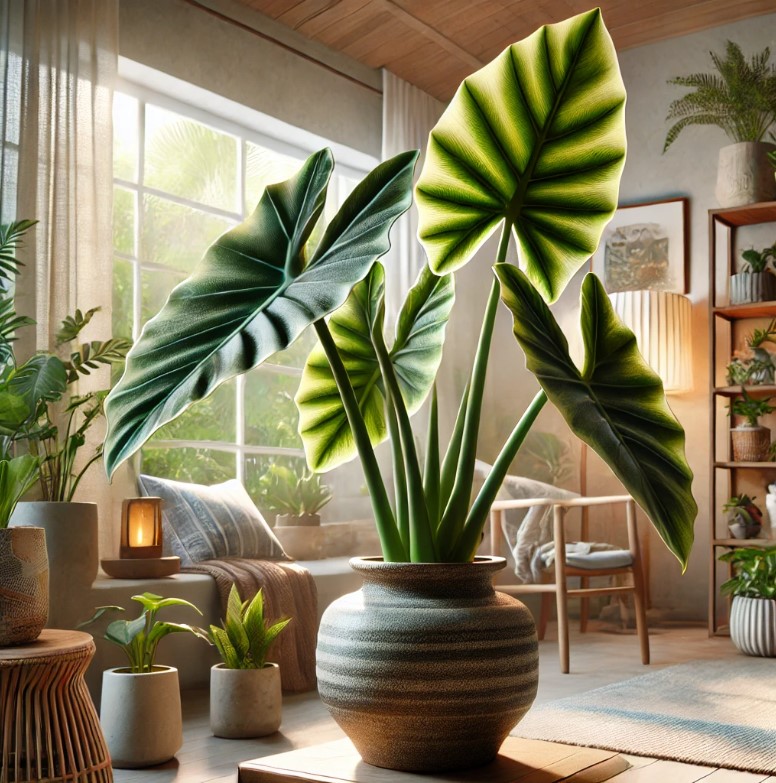Do you need something really neat and unique to add with your plant collection? The Shark Tooth plant — or Alocasia Scalprum in the botanical world is an exotic wonder that has been growing increasingly popular with bespoke rare collectors and gardening hobbyists. If you’re just getting started and want to know more about this gorgeous plant or an experienced grower looking to fill up your indoor jungle with more species, houseplants require specific care including proper light and humidity conditions. Its jagged shark tooth leaves make it one of the most visually interesting Alocasias and gives a mystical element that will enhance any indoor space. So in this post, we will be discussing the benefits of having it from Alocasia Scalprum and where to buy one plus care tips on how you can keep your new plant a happy collector. If you’re new to collecting exotic plants or if your collection is already seasoned, Alocasia Scalprum should be a staple of every indoor gardeners wish list for stunning foliage.
1. Overview of Alocasia Scalprum
Alocasia Scalprum is native to South East Asia, and highly complex in its leaf structure. The plant can reach 2 feet high, meaning that it might be a real centerpiece of your indoor garden. The dark green leaves, shiny surface and pronounced veins of Eleocharis acicularis are encased in a hard covering.
2. Distinguishing Features of Alocasia Scalprum
Leaf Shape The jagged leaves which looks like shark teeth, hence the name.
Shiny: The leaves are glossy, which helps make them look better.
Small Size: The length is short enough that you can store this indoors in a variety of places.
3. Reasons why collectors love alocasia scalprum
Rarity: Alocasia Scalprum are rare plants that avid collectors love to hunt for.
Aesthetic Appeal The eye catching foliage is a conversation starter and can work as an accent in any room.
SUSSEX PLANTER Tropical Vibe: for those who need to be surrounded by luscious green plants but are stuck inside.
4. How to Alocasia Scalprum Buy
Online Retailers : Websites such as Etsy, Amazon and specialized plant shops sometimes posted Alocasia Scalprum For sale.
Local Nurseries: A few nurseries might stock this exotic variety so it is worth looking out for around your own region.
Plant Collections Groups: Partake online forums and social media plant collectors groups for purchasing, selling or trading exotic plants.
5. Evaluating Seller Reputation
Customer Reviews: Stea reviews q, t evaluate seller credibility.
Return Policy—Make sure the seller offers a return policy if your plant arrive in poor condition.
Shipping Practices: Seek out sellers who offer packaging that will keep plants safe while in transit.
6. Healthy Alocasia Scalprum Characteristics
Vibrant Leaves: This one should be super obvious but healthy cannabis plants will have a rich green color to them meaning they shouldn’t appear yellow or purple.
Firm Stems: The stems should stand straight.
No Pests: Before you buy, check for infestation by pests.
7. How to Grow Alocasia Scalprum at The Best Ambiance
Proximity to Light: Bright, indirect light is best Excessive direct sunlight will burn the foliage.
Temperature and Humidity: Prefers Temperature Between 65°F to 85°F (18°C – 29°C) with High Levels Of Humidity.
8. Watering Guidelines
How Often to Water: Once every 7-14 days, when the top inch of soil has dried out.
Drainage: Pots should have drainage holes to prevent root rot
9. Soil Preferences
Drainage of the Potting Mix: Alocasia Scalprum needs well-draining soil.
Suggested mix: Peat with perlite and orchid bark for optimal moisture retainment without overwatering.
10. Fertilization Practices
Feeding schedule: Feed every 4 to 6 weeks with a balanced liquid food in the growing season.
No Winter Fertilization: Not all plants need to be fertilized, especially in the winter when it is mostly dormant.
11. Pruning and Maintenance
Regular Pruning: Yellowing leaves are indicators of calla lilies that need pruned.
Cleaning Leaves: Dust of leaves can be easily wipe with a damp cloth but your leave vibrant.
12. Common Pests and Diseases
Pests: Watch for spider mites, mealybugs and aphids. For infestations use neem oil or insecticidal soap
Diseases: Help to prevent diseases by providing plenty of air circulation and not over-watering.
13. Propagation Techniques
Propagation Method: Easiest propagated by division while repotting.
Division Planting: Make sure each division has a root and replant with new soil.
14. Seasonal Care Adjustments
Summer – Raise humidity levels and water more regularly to support growth.
Winter: Offer less water and do not fertilize to let the plant take some rest.
15. Conclusion
Alocasia Scalprum The plant had arrived, so I added a statement tropical elegance to my indoor space. Being quite a neat species with unique behaviors and simple enough care makes it nice for any collection. You will find the 7 things to help you grow a happy healthy Alocasia Scalprum, which as it flourishes helps purify and cleanse your rooms in this guide. Today’s fare plant can be found in our shop_NOW!
